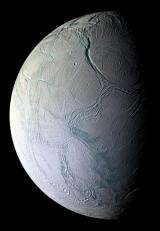Deep heat powers once-in-a-billion-year volcanoes on icy moon

(PhysOrg.com) -- New research by Macquarie University planetary scientist Dr Craig O’Neill and US colleague Francis Nimmo has found the answer to an apparent cosmic contradiction.
The mystery relates to Saturn’s tiny ice moon Enceladus. Until relatively recently, very little had been known about Enceladus, however scientists expected it to be a cold and dead place given its physical characteristics.
Then NASA’s 2005 Cassini mission flew by Enceladus at close range, and straight into an active geyser field.
Research performed by O’Neill and co-author Nimmo from the University of California, Santa Cruz is published online today by Nature Geoscience. The project was partly funded by the NASA Outer Planets Research program.
In their article, the scientists show how their computer simulations demonstrate that over billions of years the pent up energy from the tidal forces Enceladus experiences on its orbit around Saturn eventually melt its interior ice, and result in a pulse of crashing ice plates and ice volcanoes, or cryovolcanism.
“Enceladus was an enigma,” said O’Neill, who was lead scientist on the study. “Somehow it seems to be pumping out more energy than it gets, which would violate the laws of thermodynamics,” he said.
“We knew from the prior Voyager missions that Enceladus might have a complex geology, but most people thought that was in the past. Yet it turns out this 500km-across ball of ice is one of the most active moons or planets in the solar system.”
The pent-up heat - enough to melt the interior, and possibly sustain a liquid water ocean under the ice - would be released as one catastrophic event around every billion years or so. Cassini just happened to fly into it, O’Neill said.
“Eventually you reach a critical point, and the whole thing just blows,” he said.
The ice sheets would flow like glaciers, the heat causing geysers to pop up all over the active surface, he added.
It turns out the little worlds like Enceladus are among the most interesting, which makes us reflect on what we think we know of the processes that shape Earth’s interior.”
Provided by Macquarie University




















